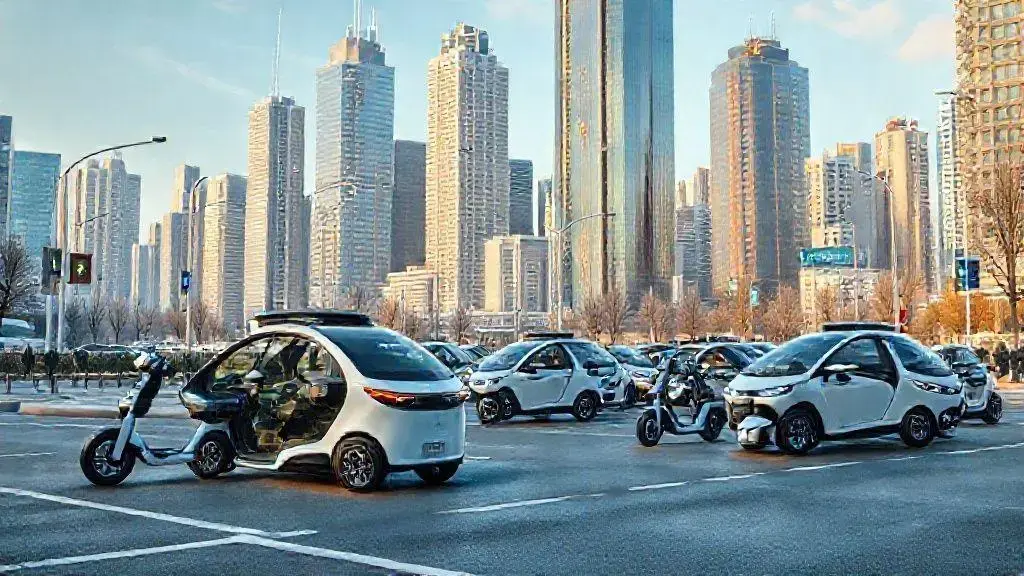Mobility trends in ride sharing services: what you need to know

The mobility trends in ride sharing services are driven by consumer preferences for convenience, safety, and flexibility, compelling companies to innovate and enhance their offerings accordingly.
Have you noticed the changing landscape of transportation lately? The world of mobility trends in ride sharing services is evolving fast, driven by technology and consumer preferences. Let’s dive into how these trends might affect your next ride.
Exploring the rise of electric vehicles in ride sharing
The rise of electric vehicles (EVs) is changing the game in ride sharing. As more consumers look for eco-friendly options, ride sharing services are adapting to meet this demand. Many companies are now incorporating electric vehicles into their fleets, improving not only the environment but also the user experience.
Benefits of Electric Vehicles in Ride Sharing
There are several advantages of using electric vehicles in the ride sharing industry. First, they produce zero emissions, which helps reduce air pollution. Additionally, electric vehicles can offer lower operating costs for ride share companies due to lower fuel and maintenance expenses.
- Zero emissions contribute to cleaner air.
- Lower operating costs enhance profitability.
- Incentives for electric vehicle use can attract more drivers.
- Riders appreciate the eco-friendly aspect, boosting demand.
Moreover, the adoption of EVs is being fortified by government incentives. Many regions offer tax breaks and rebates to both consumers and ride share companies that switch to electric vehicles. Such policies make the transition to electric mobility more financially appealing.
Challenges and Solutions
Despite the positive shift, there are challenges that come with integrating electric vehicles. A major issue is the availability of charging infrastructure. Many drivers worry about running out of battery mid-trip. However, providers are addressing this by investing in charging stations and forming partnerships with charging networks.
Another challenge is the upfront cost of electric vehicles. They can be more expensive than traditional cars, which might deter some ride share companies. However, as technology advances, these costs are decreasing. Additionally, fleet operators are now able to finance EVs more easily due to a growing number of financial institutions supporting this shift.
As the ride sharing industry continues to grow, the integration of electric vehicles will play a crucial role. This shift not only makes ride sharing more sustainable but also positions it favorably among increasingly environmentally-conscious consumers.
How AI is transforming ride sharing services

Artificial intelligence (AI) is making significant inroads into the ride sharing industry. Companies are leveraging AI to enhance service efficiency and improve customer experience. With algorithms analyzing data, ride sharing services can optimize routes and decrease wait times.
AI in Route Optimization
One of the primary applications of AI in ride sharing is route optimization. AI systems analyze traffic patterns, weather, and user demand to determine the best routes for drivers. This leads to faster pickups and drop-offs, creating a smoother experience for customers.
- Reduced travel time for passengers.
- Lower fuel costs for drivers.
- Increased availability of ride options.
Furthermore, AI helps balance supply and demand in real-time. When there is a surge in ride requests, AI can alert drivers in the area, ensuring that customers receive timely service without long waits.
Improving Safety with AI
Another important aspect of AI in ride sharing is safety. AI-driven features, such as predictive analytics, can help identify unsafe routes or flag unusual driver behavior. This not only protects passengers but also enhances the overall safety of the service.
Machine learning algorithms continuously learn from ride data, making predictions about potential incidents and taking proactive measures. For instance, if a driver often makes unsafe maneuvers, the system can suggest alternate driving patterns or provide additional training.
AI tools even assist in verifying the identity of both drivers and riders. This is crucial for building trust and ensuring a secure environment for everyone involved.
As technology continues to advance, the role of AI in ride sharing services will only grow. By automating processes and providing insights based on data, AI is reshaping how we view transportation. The future of mobility is not only more efficient but also safer and smarter.
The impact of urbanization on ride sharing trends
Urbanization is significantly changing the landscape of ride sharing services. As more people move to cities, the demand for efficient transportation options rises. This shift is influencing how ride sharing companies operate and innovate to meet the needs of urban dwellers.
Increasing Demand for Ride Sharing
With urban populations growing, there is a higher demand for ride sharing services. Busy city life often leaves people without personal vehicles. As a result, they turn to ride sharing as an affordable and convenient alternative. City dwellers appreciate the speed and ease of grabbing a ride at their fingertips, especially during rush hour or inclement weather.
- Ride sharing provides quick transportation in congested areas.
- Reduction in parking difficulties and associated costs.
- Helps reduce the reliance on personal vehicles.
This rise in urbanization also encourages ride sharing companies to expand their services. They are increasingly launching features tailored to urban consumers, such as carpool options and electric scooters.
Challenges of Urbanization
However, urbanization also presents challenges for ride sharing services. Traffic congestion can lead to longer travel times, frustrating both drivers and passengers. In addition, regulatory issues arise as municipalities try to manage the increased number of vehicles on the road.
To tackle these challenges, companies are using data analytics to understand traffic patterns better. By adjusting their strategies based on real-time data, ride sharing services can mitigate delays and enhance customer satisfaction.
As cities continue to evolve, the relationship between urbanization and ride sharing will remain crucial. Companies that adapt to these changes will likely thrive in the competitive landscape of transportation.
Consumer preferences shaping the future of ride sharing

Consumer preferences are driving significant changes in the ride sharing industry. As users demand better services and more convenient options, companies must adapt to these shifting needs. Understanding what consumers want is crucial for the success of ride sharing services.
Convenience and Accessibility
One of the top priorities for consumers is convenience. They want a simple, fast way to request rides from their smartphones. This has led to the development of user-friendly apps that allow for easy pick-up and drop-off points. Additionally, accessibility for all users, including those with disabilities, is becoming more important.
- Features like ride scheduling enhance convenience.
- Accessibility options ensure inclusivity for all riders.
- Seamless payment methods are crucial for user satisfaction.
Consumers also value the flexibility of choosing different types of rides. Options such as carpooling, luxury vehicles, or even electric scooters provide riders with personalized choices based on their needs and budgets.
Safety and Trust
Another key factor influencing consumer preferences is safety. Riders want assurance that they are in secure hands. Increased transparency around driver backgrounds and vehicle inspections is becoming essential.
Real-time tracking provides peace of mind, letting riders see their driver’s location during the wait. Many companies are implementing additional safety features, such as in-app emergency buttons, to enhance trust among users.
As the market evolves, ride sharing companies are also gathering feedback to understand consumer expectations better. This allows them to innovate and improve their services continuously. Meeting and exceeding user demands is crucial for maintaining competitiveness.
Ultimately, consumer choices will continue to shape the future of ride sharing. Those companies that prioritize customer feedback and adapt to changing preferences stand to benefit greatly in this dynamic market.
FAQ – Frequently Asked Questions about Ride Sharing Services
How are consumer preferences influencing ride sharing services?
Consumer preferences are driving changes in convenience, safety, and flexibility, pushing companies to innovate and improve their offerings.
What role does safety play in ride sharing?
Safety is a top priority, with many companies implementing background checks for drivers and real-time tracking for riders.
How do ride sharing companies collect feedback from users?
Ride sharing companies often use in-app surveys, ratings, and reviews to gather feedback and make necessary improvements.
What variety of ride options do users expect?
Users expect options like carpooling, luxury vehicles, and even scooters to fit their different needs and budgets.





